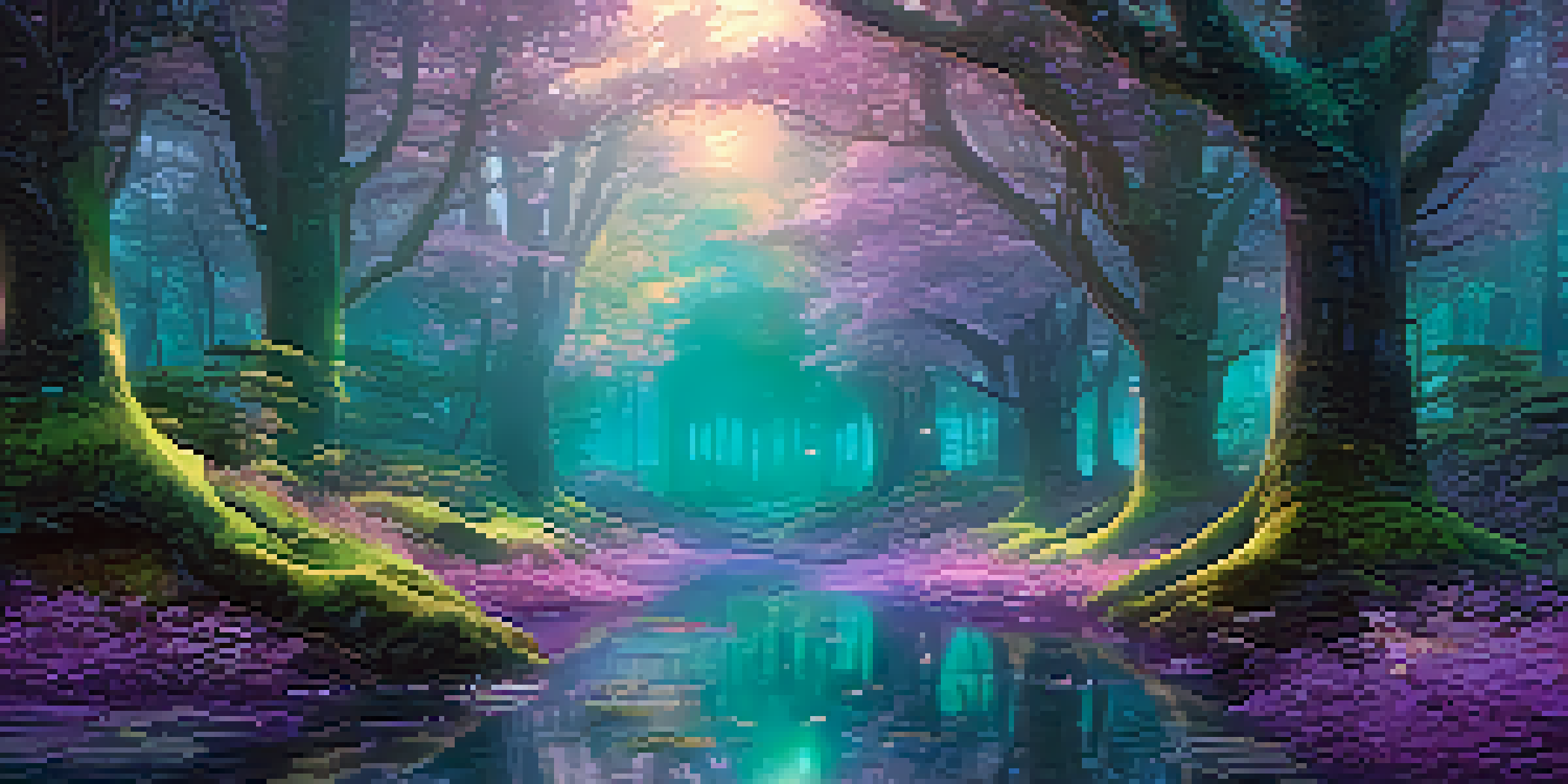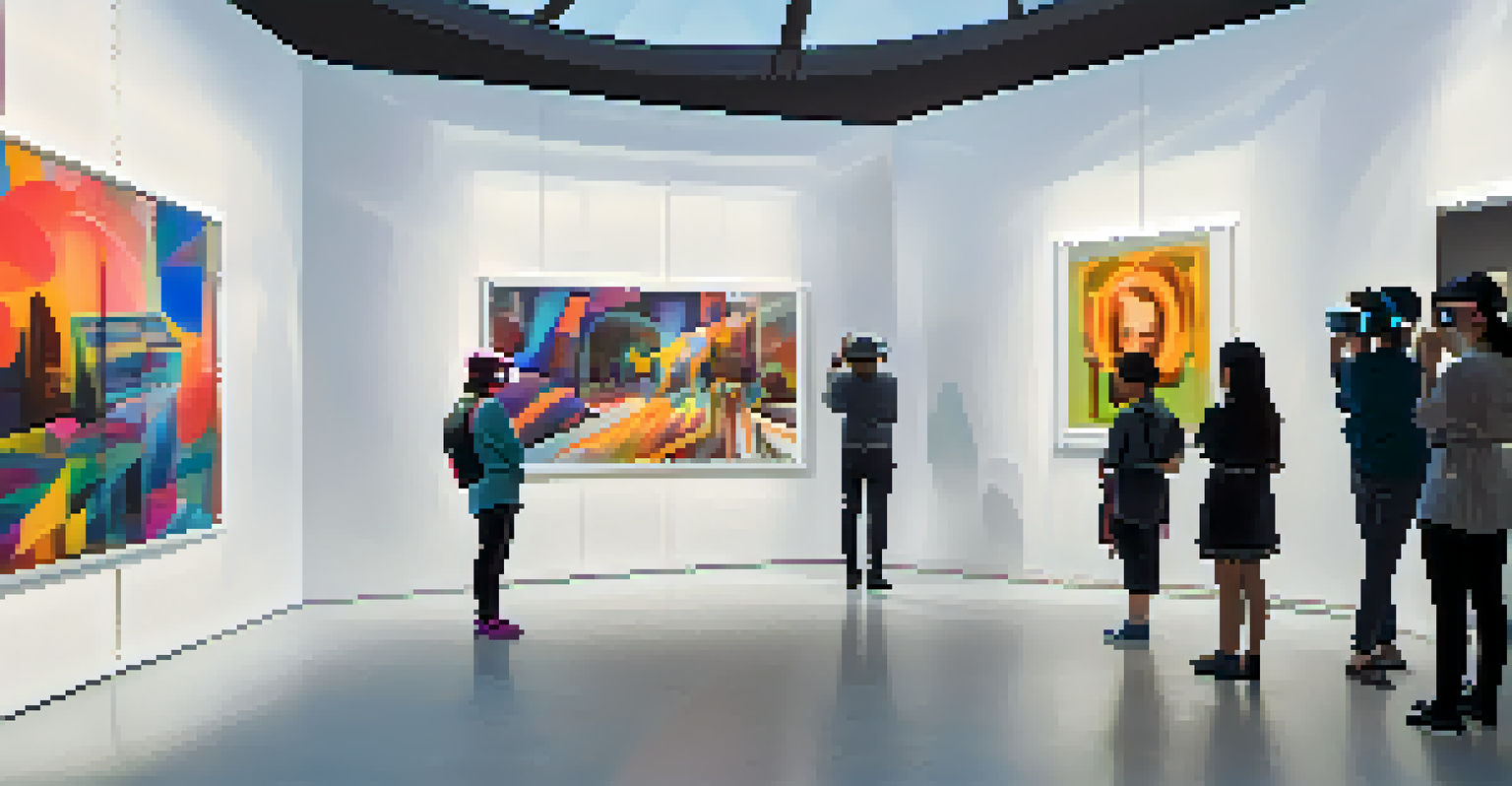The Impact of Social Media on Virtual Reality Art Trends

The Rise of Virtual Reality in the Art World
Virtual reality (VR) has emerged as a groundbreaking medium for artists, allowing them to create immersive experiences. Unlike traditional art forms, VR art transports viewers into a three-dimensional space, making them feel part of the artwork. This shift has opened up new avenues for creativity and expression, attracting both seasoned artists and newcomers eager to explore this innovative territory.
Art is not what you see, but what you make others see.
As artists experiment with VR, they find themselves inspired by the unique possibilities it offers. Imagine walking through a digital forest where colors seem to dance and sounds envelop you; this is the magic of VR art. The ability to manipulate space and perspective can lead to profoundly emotional experiences that challenge the viewer's perception of reality.
The excitement around VR art has caught the attention of the art community, leading to exhibitions and collaborations that highlight this new medium. With platforms dedicated to showcasing VR art, artists are now more visible than ever, paving the way for a vibrant, evolving landscape.
Social Media: A Catalyst for VR Art Exposure
Social media platforms like Instagram and TikTok have become vital for artists to share their VR creations. These platforms allow artists to reach a global audience, showcasing their work in ways that were previously unimaginable. By sharing short clips or immersive experiences, they can attract followers and generate interest in their art.

The visual nature of social media complements VR art perfectly, as users are drawn to stunning visuals and innovative concepts. Artists can create engaging content that encourages viewers to interact, share, and discuss their VR experiences. This not only boosts visibility but also fosters a sense of community among artists and enthusiasts alike.
VR Art Enhances Immersive Experiences
Virtual reality transforms traditional art by creating immersive environments that engage viewers on a deeper emotional level.
As artists gain traction on social media, they often collaborate with influencers and brands, further enhancing their reach. These partnerships can lead to unique projects that merge different art forms, creating a rich tapestry of creativity that resonates with diverse audiences.
The Role of User-Generated Content in VR Art
User-generated content (UGC) is transforming how VR art is created and consumed. With tools becoming more accessible, everyday users can now craft their own VR experiences, sharing them on social media platforms. This democratization of art production encourages experimentation and creativity, allowing more voices to be heard.
The future belongs to those who believe in the beauty of their dreams.
As users create and share their VR art, they contribute to a larger conversation about the medium. Their work can inspire professional artists and spark new trends, blurring the lines between creator and consumer. This collaborative spirit fosters a vibrant ecosystem where ideas can flourish and evolve.
Moreover, UGC has the potential to challenge traditional notions of authorship and originality. With multiple interpretations of a single concept emerging from different users, the art landscape becomes a dynamic space where everyone can contribute and innovate.
Engagement Metrics: Measuring Success in VR Art
As with any art form, measuring success in VR art often hinges on audience engagement. Social media provides valuable metrics such as likes, shares, and comments, helping artists gauge the impact of their work. These insights can inform future projects, allowing artists to adapt their style and content to resonate more with their audience.
Engagement also transcends mere numbers; it encompasses the emotional connection between the artist and their viewers. When people interact with VR art, they may share their experiences online, creating a ripple effect that brings even more attention to the artwork. This organic reach is invaluable in building an artist's reputation and expanding their audience.
Social Media Boosts VR Art Visibility
Platforms like Instagram and TikTok allow artists to showcase their VR creations, reaching global audiences and fostering community engagement.
Additionally, engagement metrics can attract potential collaborators and sponsors, further propelling an artist's career. Brands and galleries often look for artists who can connect with their audience, making social media engagement a critical factor in the evolving landscape of VR art.
The Influence of Trends on VR Art Creation
Trends in social media heavily influence the themes and styles present in VR art. Artists often find themselves inspired by viral challenges, popular aesthetics, or cultural movements that circulate online. This responsiveness keeps their work relevant and engaging, as they tap into current conversations and societal shifts.
For instance, the rise of sustainability awareness has led many VR artists to explore environmental themes, using their platforms to promote dialogue and action. By aligning their art with trending topics, artists can amplify their message and reach audiences who are passionate about these issues.
Moreover, trends can create a sense of urgency, pushing artists to experiment quickly and produce work that captures the moment. This fast-paced cycle can lead to innovative breakthroughs, as artists blend their unique styles with popular influences to create something entirely new.
Challenges Faced by VR Artists in a Social Media Landscape
While social media offers numerous opportunities for VR artists, it also presents challenges that can hinder creativity. The pressure to produce content that performs well can lead to burnout, causing artists to prioritize popularity over authenticity. This struggle can diminish the joy of creating and result in art that feels forced or insincere.
Additionally, the fast-paced nature of social media can overshadow the depth and complexity of VR art. With trends changing rapidly, artists may feel compelled to follow the crowd rather than explore their unique vision. This can lead to a homogenization of content, making it difficult for artists to stand out.
User-Generated Content Shapes VR Art
The rise of user-generated content democratizes art creation, enabling everyday users to contribute and innovate within the VR art landscape.
Lastly, navigating the algorithms of social media platforms can be daunting. Artists may need to constantly adapt their strategies to ensure their work reaches the intended audience, diverting attention away from the creative process. Balancing artistic integrity with the demands of social media can be a delicate dance for many VR artists.
The Future of VR Art in the Age of Social Media
As both VR art and social media continue to evolve, the future looks bright for this intersection of creativity. New technologies, such as augmented reality (AR) and artificial intelligence (AI), are poised to enhance the VR experience, offering even more tools for artists to explore. This innovation will likely lead to exciting collaborations and fresh ideas that push the boundaries of art.
Furthermore, as the audience for VR art grows, so does the potential for new platforms dedicated to this medium. Artists may find opportunities to showcase their work in virtual galleries or immersive experiences that engage viewers in novel ways. This shift could lead to a new era of appreciation for VR art, elevating it to the same level as traditional forms.

Ultimately, the relationship between social media and VR art will continue to shape the creative landscape. As artists embrace the possibilities and challenges presented by these platforms, we can expect to see a rich tapestry of innovation that reflects the diverse voices and visions of today's artists.